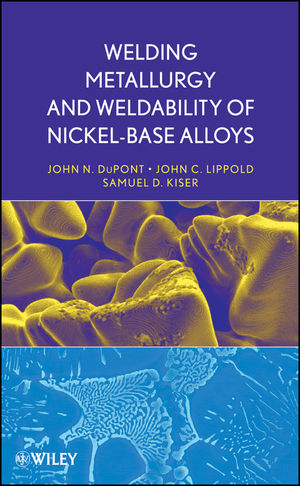Welding Metallurgy and Weldability of Nickel-Base AlloysISBN: 978-0-470-08714-5
Hardcover
456 pages
October 2009
 This is a Print-on-Demand title. It will be printed specifically to fill your order. Please allow an additional 10-15 days delivery time. The book is not returnable.
|
||||||
Preface xiii
1. Introduction 1
1.1 Ni-base Alloy Classification 2
1.1.1 Commercially Pure Nickel Alloys 2
1.1.2 Solid-Solution Strengthened Alloys 3
1.1.3 Precipitation-Strengthened Alloys 4
1.1.4 Other Specialty Alloys 5
1.2 History of Nickel and Ni-base Alloys 5
1.3 Corrosion Resistance 11
1.4 Nickel Alloy Production 12
References 14
2. Alloying Additions, Phase Diagrams, and Phase Stability 15
2.1 Introduction 15
2.2 General Influence of Alloying Additions 16
2.3 Phase Diagrams for Solid-Solution Alloys 20
2.3.1 The Ni-Cu System 20
2.3.2 The Ni-Cr System 21
2.3.3 Ni-Mo System 22
2.3.4 The Ni-Fe-Cr System 22
2.3.5 Ni-Cr-Mo System 24
2.4 Phase Diagrams for Precipitation Hardened Alloys— ¶′ nFormers 26
2.5 Phase Diagrams for Precipitation-Hardened Alloys— ¶″ nFormers 30
2.6 Calculated Phase Stability Diagrams 33
2.7 PHACOMP Phase Stability Calculations 40
References 43
3. Solid-Solution Strengthened Ni-base Alloys 47
3.1 Standard Alloys and Consumables 47
3.2 Physical Metallurgy and Mechanical Properties 51
3.3 Welding Metallurgy 57
3.3.1 Microstructural Evolution in the Fusion Zone 57
3.3.2 Heat Affected Zone 81
3.3.3 Postweld Heat Treatment 82
3.4 Mechanical Properties of Weldments 91
3.4.1 Hydrogen Effects 91
3.4.2 Postweld Heat Treatment 93
3.5 Weldability 100
3.5.1 Fusion Zone Solidification Cracking 100
3.5.2 HAZ Liquation Cracking 118
3.5.3 Avoiding Solidification and Liquation Cracking 123
3.5.4 Ductility-Dip Cracking 128
3.6 Corrosion Resistance 143
3.7 Case Studies 149
3.7.1 Pitting Corrosion in MONEL Welds 149
References 150
4. Precipitation-Strengthened Ni-base Alloys 157
4.1 Standard Alloys and Consumables 158
4.2 Physical Metallurgy and Mechanical Properties 161
4.3 Welding Metallurgy 173
4.3.1 Microstructural Evolution in the Fusion Zone 173
4.3.2 Heat-Affected Zone 201
4.3.3 Postweld Heat Treatment 204
4.4 Mechanical Properties of Weldments 206
4.5 Weldability 207
4.5.1 Solidification Cracking 208
4.5.2 HAZ Liquation Cracking 223
4.5.3 Strain-Age Cracking 235
References 248
5. Oxide Dispersion Strengthened Alloys and Nickel Aluminides 255
5.1 Oxide Dispersion Strengthened Alloys 255
5.1.1 Physical and Mechanical Metallurgy 255
5.1.2 Welding Metallurgy 259
5.1.3 Summary of the Weldability of ODS Alloys 268
5.2 Nickel Aluminide Alloys 268
5.2.1 Physical and Mechanical Metallurgy 268
5.2.2 Weldability of the Ni-Aluminides 272
5.2.3 Summary of the Weldability of Nickel Aluminide Alloys 276
References 278
6. Repair Welding of Ni-base Alloys 281
6.1 Solid-Solution Strengthened Alloys 281
6.2 Precipitation-Strengthened Alloys 283
6.2.1 Alloy 718 284
6.2.2 Waspaloy 295
6.3 Single Crystal Superalloys 298
6.3.1 Control of Single Crystal Weld Repairs 302
6.3.2 Solidification Cracking 314
6.3.3 Optimizing Processing Parameters 317
References 324
7. Dissimilar Welding 327
7.1 Application of Dissimilar Welds 327
7.2 Influence of Process Parameters on Fusion Zone Composition 328
7.3 Carbon, Low Alloy and Stainless Steels 331
7.3.1 Determining Weld Metal Constitution 332
7.3.2 Fusion Boundary Transition Region 334
7.3.3 Weldability 342
7.4 Postweld Heat Treatment Cracking in Stainless Steels Welded with Ni-base Filler Metals 347
7.5 Super Austenitic Stainless Steels 349
7.6 Dissimilar Welds in Ni-base Alloys—Effect on Corrosion Resistance 357
7.7 9%Ni Steels 357
7.7.1 Physical Metallurgy of 9%Ni Steels 357
7.7.2 Hot Cracking of Ni-base Deposits 361
7.8 Super Duplex Stainless Steels 363
7.9 Case Studies 364
7.9.1 Postweld Heat Treatment Cracking of Thick Section Welds in Alloy 800H Made with
ENiCrFe-2 Filler Metal 364
7.9.2 Alloy 925 Welded with ERNiCrMo-15 (INCO-WELD 725NDUR) for Manufacturing Vacuum Insulated Oil Patch Tubing 367
7.9.3 Corrosion-Fatigue of Alloy 625 Weld Overlays 369
7.9.4 Overlay of “Safe-End” Welds using High-Cr, Ni-base Filler Metals 373
References 376
8. Weldability Testing 379
8.1 Introduction 379
8.1.1 Weldability Testing Approaches 380
8.1.2 Types of Weldability Test Techniques 380
8.2 The Varestraint Test 381
8.2.1 Technique for Quantifying Weld Solidification Cracking 383
8.2.2 Technique for Quantifying HAZ Liquation Cracking 386
8.3 Modified Cast Pin Tear Test 388
8.4 The Sigmajig Test 392
8.5 The Hot Ductility Test 394
8.6 The Strain-to-Fracture Test 399
8.7 Other Weldability Tests 401
References 402
Appendix A Composition of Wrought and Cast Nickel-Base Alloys 403
Appendix B Composition of Nickel and Nickel Alloy Consumables 409
Appendix C Corrosion Acceptance Testing Methods 415
Appendix D Etching Techniques for Ni-base Alloys and Welds 419
Author Index 423
Subject Index 431



